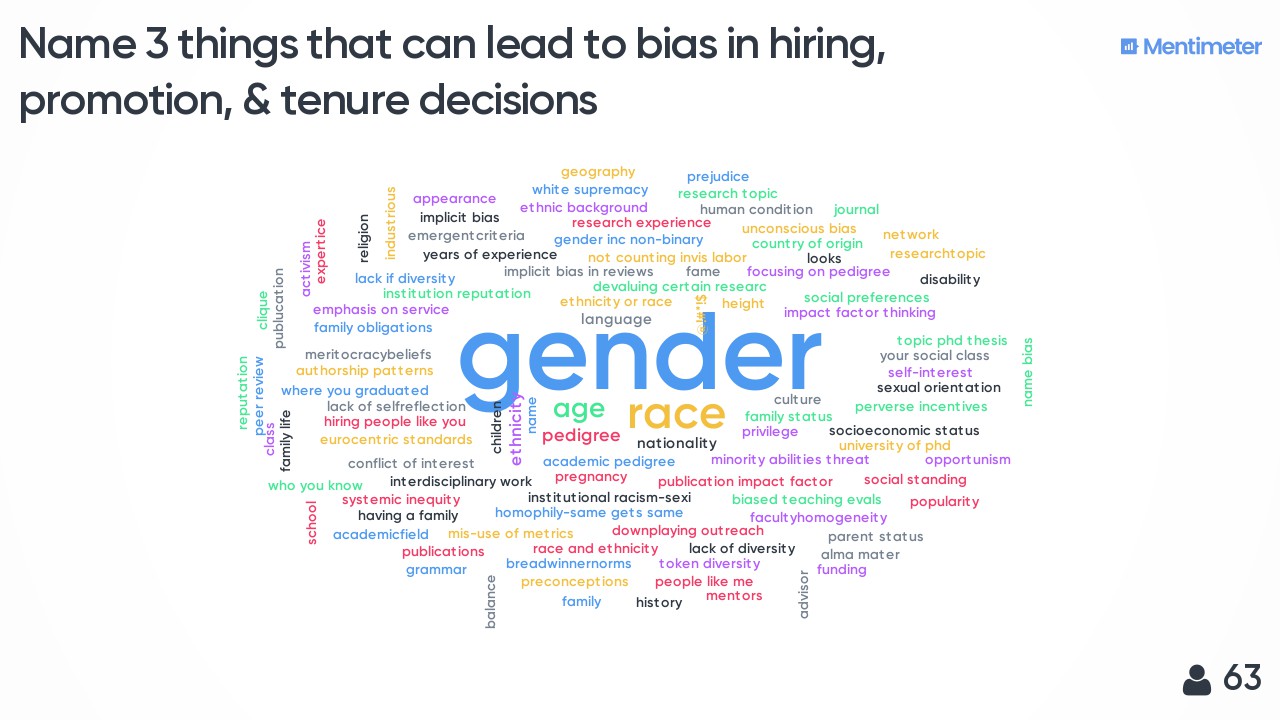While hiring, promotion, and tenure decisions in academia are in principle based on the merit of scholarly contributions, implicit biases influence who we hire and who we promote. Even if they are unintentional, biases have consequences.
At the AAAS meeting in Washington, DC, this February, we explored approaches to addressing bias and increasing the diversity of the academic workforce in the session, “Academic Research Assessment: Reducing Biases in Evaluation.” Panelists included Patricia Devine, Kenneth and Mamie Clark Professor of Psychology at the University of Wisconsin—Madison; Sherilynn Black, Associate Vice Provost for Faculty Advancement and Assistant Professor of Medical Education at Duke University; and Stephen Curry, Assistant Provost for Equality, Diversity, and Inclusion at Imperial College and Chair of the DORA Steering Committee. The panel was moderated by Anna Hatch, DORA community manager.
To help frame the discussion, attendees and Twitter users were asked to name three things that lead to bias in hiring, promotion, and tenure decisions. Gender and race were the two most prominent responses. A few additional themes materialized from clusters of similar responses, including having a family or the reputation of the institution where one works.

In his talk, Curry described a general three-step work flow to address bias in the academic community:
- Define the nature and scale of the problem.
- Understand its root causes.
- Design and test tools and processes to fix it.
There is no shortage of evidence describing how bias can affect the academic workforce. In instances of joint authorship that reflect equal contributions on research articles, a recent study revealed that male authors are more likely to be listed before their female counterparts (Broderick and Casadevall, 2019). While merit is associated with productivity for men when they are evaluated by peer review, the same is not true for women or other underrepresented minorities in Sweden (Holst and Hägg, 2017). An article examining gender gaps in Canada concluded that “gender gaps in grant funding are attributable to less favorable assessments of women as principal investigators, not of the quality of their proposed research” (Witteman et al, 2019). In the UK, 92% of professors are white (Equality Challenge Unit, 2017).
Final session for the day starting with @DevineLab on how to break the bias habit. Bias is a reflex, the resulting actions are a choice. Recognize thoughts that reflect a bias. Look to interrogate that thought. Leverage that point for change. #AAAAmtg #AAAS2019 pic.twitter.com/8tzwTQ63Lh
— Layne will call you Dr. ________ (@LayneScherer) February 16, 2019
One root cause is unintentional bias, which can persist even among those who renounce prejudice. Devine explained that people are exposed to stereotypes early and often, which creates a “habit of the mind.” Meaning that bias is ordinary; it is not a moral failing. However, biases do have consequences; they disadvantage stereotyped groups.
Part of Devine’s research focuses on interventions to break the bias habit (Devine et al., 2012; Forscher et al 2017). To foster institutional change, Devine focuses on individuals. One way is to encourage people to stop, slow down, and think about values when they make decisions. She showed how a 2.5-hour “Breaking the Bias Habit” workshop increased the number of female STEM faculty hires by 18 percentage points in departments receiving the intervention as part of a cluster randomized, controlled trial at UW-Madison (Carnes et al., 2015; Devine et al., 2017). The number of new hires in control departments did not change. Devine emphasized that there is no magic bullet, saying a multifaceted problem like this requires a multi-pronged solution.
Faculty hiring and promotion decisions are not the only place in the pipeline to target. Black is working to reduce disparities at the student level at Duke University. “Culturally aware mentoring is a critical tool for creating an inclusive environment,” she said. “Diversity builds the intellectual tension that pushes us to be progressive.” Academia was not originally formed to be inclusive, but Black is fixing that by taking a data-driven approach to help underrepresented students succeed and using cohorts to build community and wellness through the Duke Biosciences Collaborative for Research Engagement (BioCoRe) program. To ensure success, they have partnered with a number of departments across campus as well as outside institutions and organizations. Their work is paying off. The number of applications from underrepresented individuals has been exponentially increasing since the start of their new recruitment approach in 2011.
There are many forms of bias in assessment, some of which can be hidden in the numbers used to evaluate scientists. “Journal impact factors have been stereotyping research papers since 1972,” said Curry. He described how the prestige economy in academia created a problematic system of incentives and rewards that creates a zero-sum mindset. Despite its several documented deficiencies as an evaluation tool (DORA, 2013), the journal impact factor and other journal-based metrics drive the complex incentive and reward system in academia.
DORA is working to build communities of practice and rethink measures of success. Assessment criteria do not have to be limited to journal impact factors. Other activities and aspects of scholarly work include: research, publications and grants; managerial and academic duties; mentoring and teaching; clinical work (if applicable); entrepreneurship and outreach; and more.
New tools are essential to break old habits, says Curry. The Charité University Hospital in Berlin created a structured narrative for those applying for professorships to describe contributions to research, open science, team science, and interactions with stakeholders. DORA is helping other institutions succeed by disseminating examples of good practice and other resources on the website. “In moving towards a more nuanced qualitative system of peer review, we need to ensure processes are built-in that reduce bias,” says Curry. This can include the careful use of language in job advertisements, de-identifying candidates at triage stages of the application process, bias training for panels, diverse review panels, and a value-driven interview.
